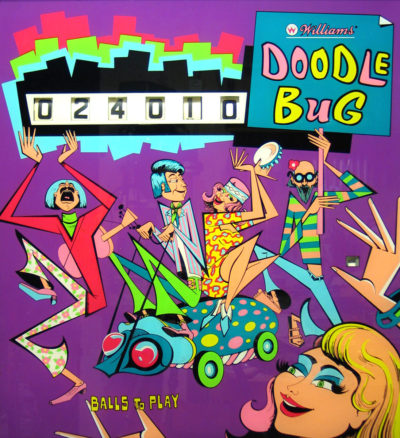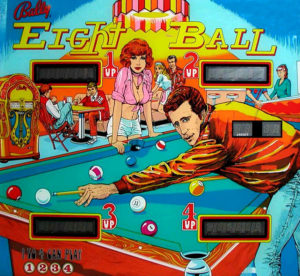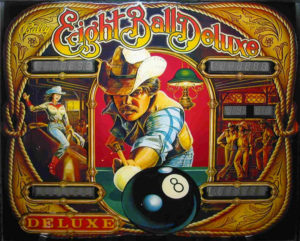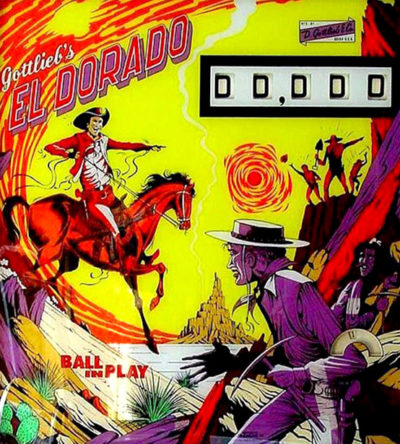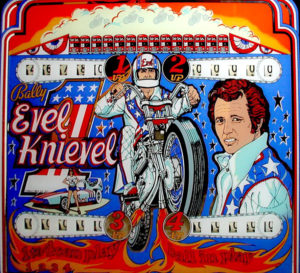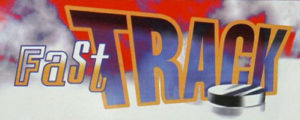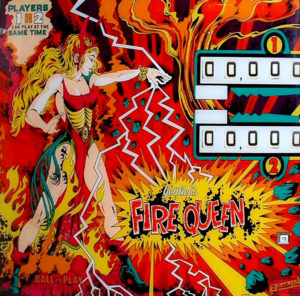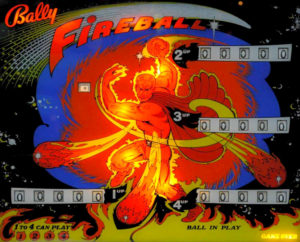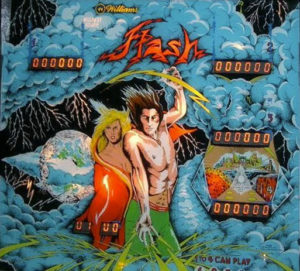-
This Norm Clark and Christian Marsche creation was also produced in an add-a-ball version called Love Bug as well as a four-player version called Dipsy Doodle. This symmetrical playfield design has a captive ball under the playfield which, when activated, rolls over a switch to score a bonus batch of points based on the value of the button when the feature is lit. The top kickout hole randomly selects bonus features to make the game more intriguing. A popup post between the flippers prevents ball drain down the middle of the playfield, but this post may be retracted just at the wrong time if the down-post targets are hit. An extra ball may be achieved if the center target is lit. This target also activates the “doodlebug” under the playfield. Finally, a free ball gate is incorporated into the machine if the appropriate combination of pop bumpers and rollovers are made. A fast-paced game that was popular in its day.If you like “Happy Days” of TV fame, you’ll immediately notice “The Fonz” on the backglass. George Christian designed this machine and Paul Faris penned the artwork package. The machine was very popular in the early days of solid-state pinball. 20,230 games were made and most of them were played down to the wood subsurface under the artwork due to excessive play. The pool-themed game is set up so that players one and three’s goal is to score balls 1 to 7 and players two and four are after the 9 to 15 balls. Once completed, the eight-ball target lights. This machine has a built-in memory recall of each player’s efforts and the game continues on your next ball where you left off. Bonus awards are 3,000 points per ball lit with a holdover feature from your previous accomplishments. The right bonus lane advances the winnings by 2x, 3x, 5x , super bonus, extra balls and specials.This game was very successful for the Bally company. It was initially released in 1981 as a full upright pinball with a production of 8,250 games. This version of the game in its third release had a run of 8,850 games. This cabinet was a unique design for Bally, as was used in a few other games like Pac-Man pinball. Designed by George Christian with art by Margaret Hudson, the pool-themed game is a classic. The basic object here is to hit all seven drop targets representing pool balls. The eight-ball drop target then pops up. Upon hitting it, “deluxe” lights up behind where the drop targets were. Making “deluxe” increases your bonus upon completion of the ball and advances the deluxe hold-over feature on the backglass. Hitting the in-line drop targets awards points and specials. The same is true if you shoot the left ramp to the top.November marks the month of this game’s release. Design was one of Ed Krynski’s and art package was penned by Gordon Morison. This game had an add-a-ball version called Gold Strike as well as a re-released solid-state version. Gottlieb also duplicated this game design in Target Alpha (in the museum) and Canada Dry. 2,875 units were produced. If you like drop targets, this is your game. A battery of 10 drop targets are in the top of the playfield and a battery of 5 on the right mid-center. Four flippers are present for aiming at your foe. If you’re skillful enough to complete all the targets, a replay is awarded, 5,000 points are added, and a special lights up to score a replay if hit. If you drain your ball, the targets reset. An advancing light under the drop targets awards 5,000 points instead of the usual 500 points if you hit the drop target when it’s up and appropriately lit. Rollovers score 5,000 points when lit. Score awards replays also as well as matching.(Electromechanical Version) Bally released Evel Knievel in June of the year. Both electromechanical and solid-state versions of the game were fabricated. The reason two different platforms were made was due to the newness of the solid-state platform not being fully trusted or many arcade operators not being versed in the solid-state computerized machines. The “old faithful” mechanical versions used the same technology since the beginning of pinball that included relays, steppers, and score motors. This game was produced in mass quantity in the solid-state format with 14,000 pieces being fabricated. This game is one of only 155 made. This is probably one of the best examples of this rare run of machines. The play parallels the solid-state version, but an accumulated memory of targets hit isn’t stored in memory and awarded. This game just remembers your last hit of the last target. Enjoy!Gottlieb released the game “Sinbad” in both solid-state and electromechanical formats in June of the year. Designed by Ed Krynski with art by Gordon Morison, there were 12,000 S.S. games and 950 E.M. games made. This machine is the rare two-player version of the game, of which 730 were made. Drop targets are the main theme of this game. Knocking down the single white drop target awards a 2x bonus and lights the white rollover. The three yellow drops were next. If hit, 3x bonus is awarded when the ball drains and the 5,000 rollover lights at the top of the playfield. The four purple drops were next. Making these would award 4x bonus and light the extra ball rollover. Finally, the five red drops; when hit would award 5x bonus (the maximum bonus that could register is 15,000 points times the bonus) as well as light the special rollover. Four flippers allowed for interesting play, also.Two banks of 5 drop targets, with two kickout holes above the drop targets. Three pop bumpers, no slingshots, and two 3″ flippers. The game play/rules behind Fastdraw is rather interesting, and a bit complicated for an EM pinball. First try and score the three A-B-C rollover targets. This increases the score value of the two kickout holes (1000 points plus another 1000 for each of the scored A-B-C rollovers, for a possible 4000 points max per kickout hole). Each of the three rollovers corresponds to a pop bumper too, so scoring the “A” rollover lights its pop bumper scoring 100 points instead of 10 points. Getting the three A-B-C rollovers also turns on the “extra bonus” light (double bonus for all but the last ball). Last ball gets double bonus by default, and if the A-B-C rollover lanes are scored, triple bonus is awarded. After the A-B-C rollovers are scored, knocking down all 5 of either the right or left drop target banks will also light the corresponding right or left kickout hole for Special. (The center pop bumper alternates the Special between the right and left kickout hole.) Also each drop target knocked down increases the end-of-ball bonus by 1000 points. Finally, knocking down all 10 drop targets makes the game raise the single center black drop target on each of the two drop banks. Now this single drop target is worth 5000 points. If one of the two center black drop targets is down, again that corresponding kickout hole will alternate lit as Special (assuming the A-B-C rollovers have been scored). If both black single drop targets are knocked down, the game resets these two black drop targets again. At the end of ball all targets and features reset, so it’s rinse and repeat for the next ball/player.This replay game came out in December of the year with a four-player replay version (Vulcan) being released two months prior. 970 units were produced. Ed Krynski designed the game with Gordon Morison taking the credit for artwork. Two sets of drop targets in the firing range of the flippers make for a lot of accurate target shooting. Lighting all four green drop targets lights the extra ball target. The bonus value is doubled by hitting the bank of five drop targets. Making one to five numbered sequence lights two rollovers for a special as well as increases the white drop target value to three bonus advances. The kickout hole awards from 1,000 to 5,000 points dependent on the number of green drop targets hit at that moment in time. All in all, a nicely balanced game. Bonus is awarded upon draining the ball also.This is it. The ultimate collectible game of the ‘70s according to the literature. Bally put together Ted Zale and Dave “Mad Dog” Christianson to design the game. Production run was 3,815 units. Many firsts here. The whirlwind spinning disk was a first to throw off the ball once rolled upon. A messenger ball (captive ball) was a variation on a theme. The art package is truly amazing. A lower-left kick-back kicker, when activated, returns your ball to play. A free ball gate returns your ball to the plunger. “Zipperflippers”, a first, closes the gap between the flippers, when activated, preventing the loss of the ball thru the center drain until turned off. Once you lock two balls in the “odin” and “wotan” kickout holes, then hit “release messenger balls”, three balls are in play. No jackpot in multiball in this game was developed. You just had a period of high scoring and pinball chaos to contend with until you lost the first two balls in play.This game was a breakthru game for Williams in January. It was designed by Steve Ritchie with art by Constantino Mitchell. Flash was the first game to have a continous background sound during play and the crescendo of the sound sped up as you advanced thru the game. This is also the first game to use “flash lamps”, which are higher voltage lights that really make a presence when they light. The first thing you notice on this non-speaking game is, when you shoot the ball from the plunger, the ball travels diagonally across the playfield and ends at the top of the playfield from left to right. The top rollovers consist of 4 numbers. If you hit 1-3, you get a double bonus; all four made gives a triple bonus. 19,505 games were made, a big production run. This game also has the advance bonus eject hole, drop targets, and, of course, the bright “flash” show when activated. This game was a main staple in arcades of the ’80s.This Gottlieb game is one of the five in the museum of the “flipper” series from Gottlieb. These games are all add-a-ball games. The layout of this game parallels a future Gottlieb classic by the name of “Buckaroo” (also in the museum). 1,550 of these machines were manufactured. Wayne Neyens designed the game and Roy Parker established the art package. Fifteen targets on the roto-target are present and spinning the roto would bring up new numbers to complete. If you are skillful enough to sequence four numbers in a row, an extra ball is awarded. The bull’s-eye target awards an extra ball also. Each time an extra ball is awarded, the backglass animation activates. The cowboy shoots at the targets, which causes them to spin. No match feature here and tilting the game forfeits the ball in play as well as a future ball in play.
-
This Norm Clark and Christian Marsche creation was also produced in an add-a-ball version called Love Bug as well as a four-player version called Dipsy Doodle. This symmetrical playfield design has a captive ball under the playfield which, when activated, rolls over a switch to score a bonus batch of points based on the value of the button when the feature is lit. The top kickout hole randomly selects bonus features to make the game more intriguing. A popup post between the flippers prevents ball drain down the middle of the playfield, but this post may be retracted just at the wrong time if the down-post targets are hit. An extra ball may be achieved if the center target is lit. This target also activates the “doodlebug” under the playfield. Finally, a free ball gate is incorporated into the machine if the appropriate combination of pop bumpers and rollovers are made. A fast-paced game that was popular in its day.



